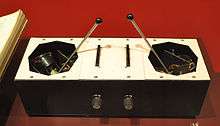Azimuth Co-ordinator

The Azimuth Co-ordinator was the first panning control for a quadraphonic sound system, at that time a new concept. Pink Floyd became the first band to use it in their early shows.
The Azimuth Co-ordinator uses four rotary rheostats housed in a large box. The rheostats were converted from their standard 270 degrees rotation to operate over the narrower 90 degree range imposed by the physical constraints of the control lever with the box top aperture. The system was operated by operating two joysticks, which allowed an audio signal to be panned between up to six loudspeakers placed around the hall.
The Azimuth Co-ordinator was operated by keyboardist Richard Wright. As he operated the joystick, the source of the sound moved from speaker to speaker around the auditorium. With the controls in the central position, the sound output would be equal in all speakers.
It was constructed by a technical engineer Bernard Speight at EMI’s Abbey Road Studios. The original was stolen after the first concert in Queen Elizabeth Hall in London, England. A second was built for the concert at the Royal Festival Hall in London on 14 April 1969. It had two pan pots and four channels.
Lost for many years it has now been found under the aegis of London’s Victoria and Albert Museum, displayed as part of their Theatre Collections gallery [1] since March 2009.
References
- ↑ "pink floyd". Archived from the original on 21 August 2009. Retrieved 2009-08-14.
- The New Musical Express Book of Rock, 1975, Star Books, ISBN 0-352-30074-4
External links
| Wikimedia Commons has media related to Azimuth Co-ordinators. |
- Pink Floyd's Azimuth Co-ordinator on show at V&A Museum
- 12 May 1967: Pink Floyd Astounds With 'Sound in the Round'
- V & A Museum Object No. S.294-1980, Sound equipment, Azimuth co-ordinator